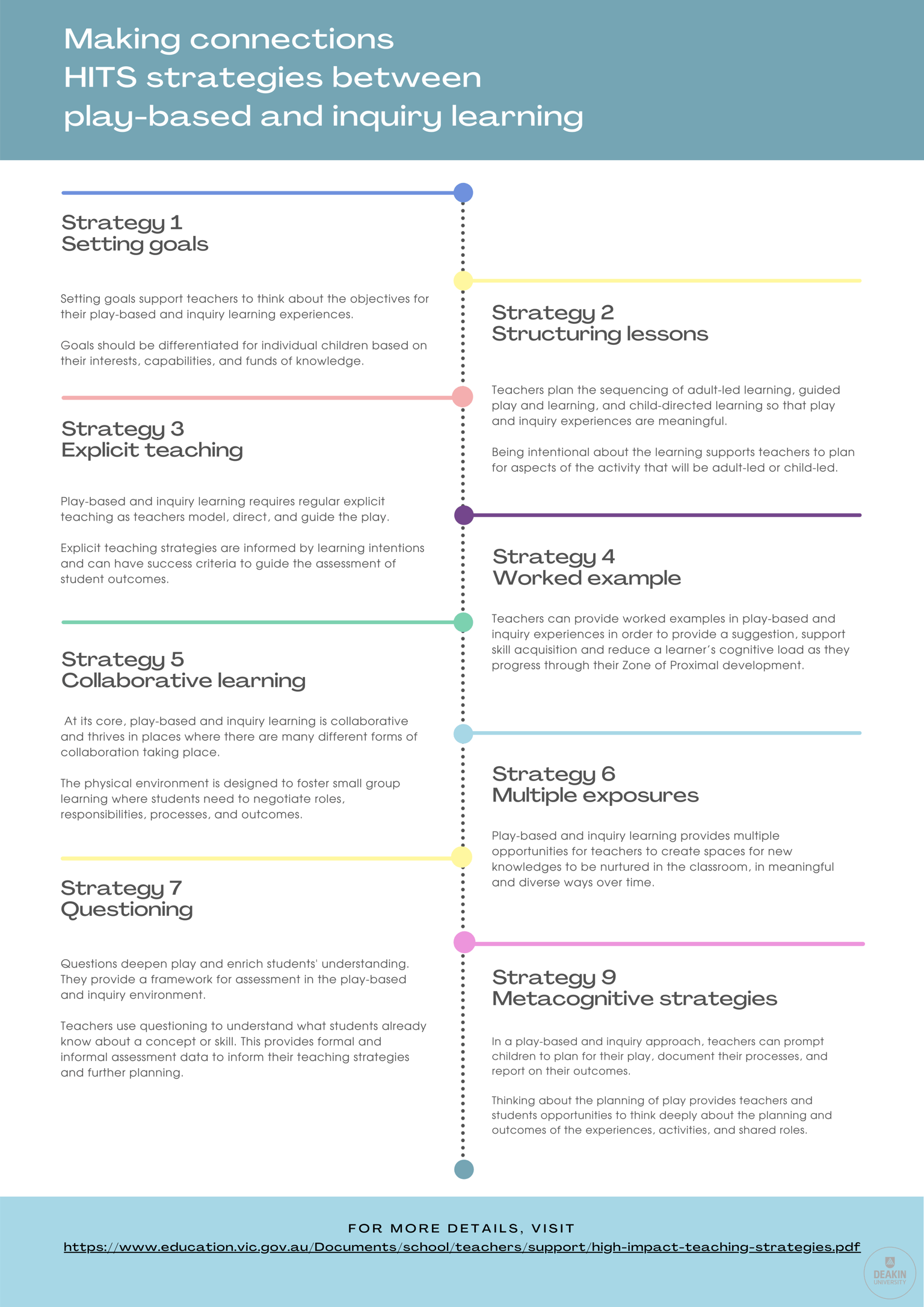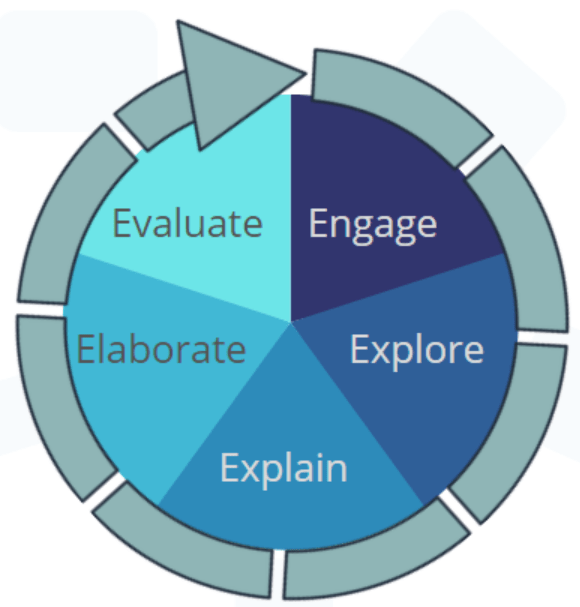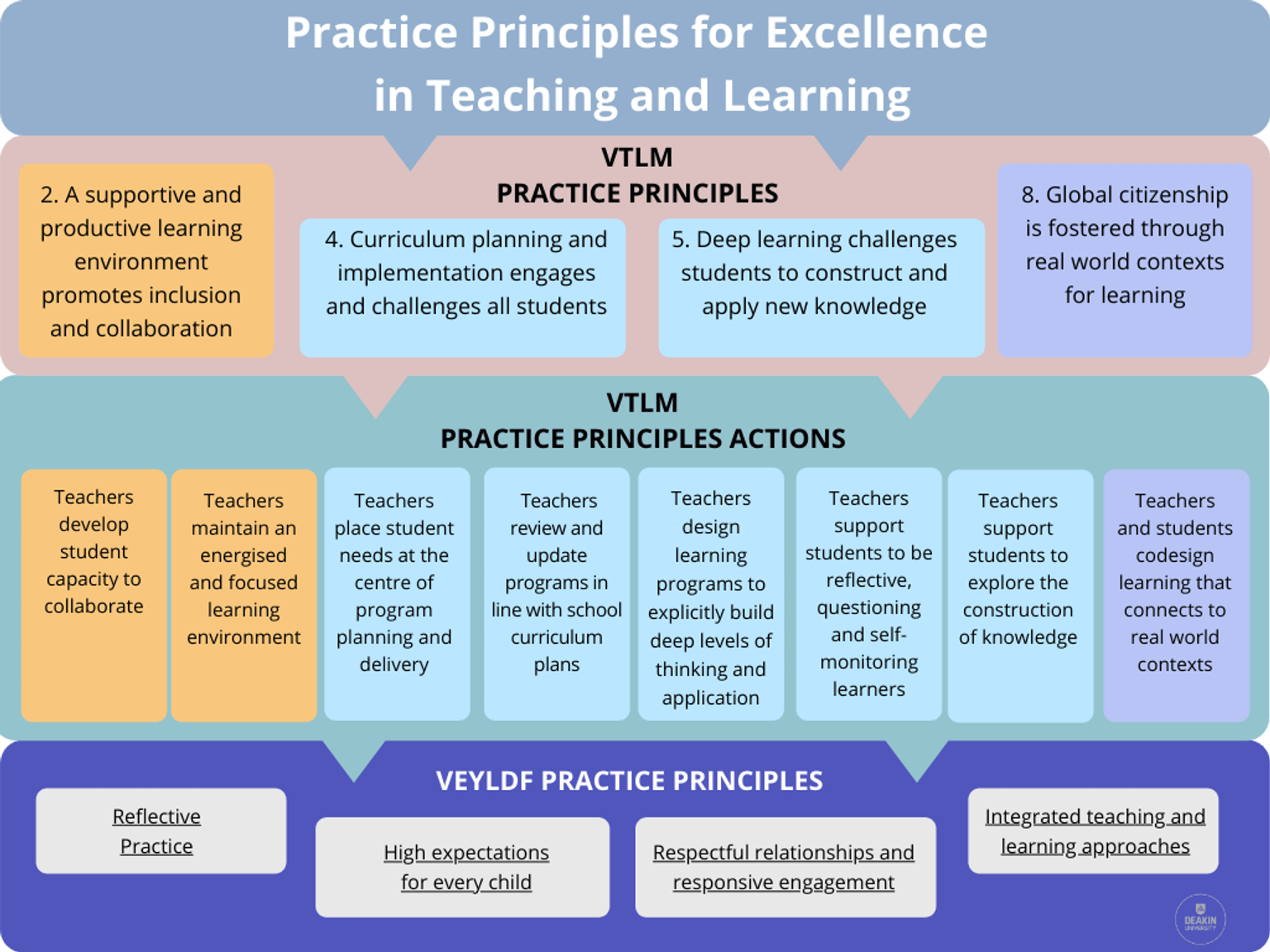Module 2.1: Introduction to Module 2
We acknowledge all Aboriginal and Torres Strait Islander peoples as the first sovereign people of this land.
As a community of educators, we recognise with deep respect their continuing connections to lands, waters, knowledges and cultures. In doing so we pay our respects to their Elders past, present and emerging.
Objectives of the module
In Module 2, we explore creating supportive environments for the implementation of play-based and inquiry learning for diverse learners. Teachers may find new sources and ideas for resourcing, teaching, creating play spaces, and employing effective teaching strategies for play-based and inquiry learning approaches.
At the completion of this module, teachers will be able to further apply their skills in developing effective indoor and outdoor environments that support play-based and inquiry learning.
As indicated in Module 1, research has shown that play and inquiry have an important place in the education of primary-aged students (Stagnitti, Paatsch, Nolan & Campbell, 2020). This is especially relevant for many of the students whose kindergarten and play experiences with peers may have been limited due to the COVID-19 pandemic.
Foundation teachers have an important role in supporting children’s transition through play-based and inquiry learning, to provide personal and social learning environments that facilitate young children’s learning capabilities, dispositions and processes to adapt to formal education in this challenging time.
Many of you may already be implementing a play-based and inquiry learning approach. This professional learning is intended to extend your knowledge and support your understandings and practices. For some, this will be confirmation of your practice. For others, it provides a different way of viewing teaching and learning. In this module, we trust that you will continue to see the benefits of play-based and inquiry learning in the early years of schooling and how it can be further implemented in your classrooms.
Welcome video
Watch a video where Associate Professor Anne-Marie Morrissey and Dr Deb Moore introduce themselves as facilitators for this module.
Reference: Acknowledgment to Country used in the video can be found in Nadia Wheatley’s (2006) picture storybook Going Bush.
The teacher’s role in play-based and inquiry learning
There can sometimes be a misconception that adults do not have a role in children’s play and inquiry experiences. Supporting play-based and inquiry learning is much more active than providing play resources and then standing back to let children play. Teachers must flexibly adjust their role as children move through different phases of play and inquiry.
The teacher’s role in a play-based and inquiry learning approach is particularly important in the Foundation year of schooling. In this crucial year, effective organisation of spaces, resources and considered interactions foster student learning. See the Early Years Planning Cycle to demonstrate how the Victorian Early Years Learning and Development (VEYLDF) planning cycle can be applied to observe, assess and respond to evidence of children’s learning.
Connecting integrated teaching and learning to the VEYLDF
The diagram below from the VEYLDF (DET, 2018) illustrates how teachers’ roles and strategies to support play-based and inquiry learning can change over a period of time and/or within a single play episode.
The diagram represents an integrated teaching and learning approach (VEYLDF practice), whereby the teacher’s role in play and inquiry experiences are purposeful and varied to support student learning and engagement. Play is central to the concept of integrated teaching and learning approaches and essential to stimulate and integrate a wide range of children’s intellectual, physical, social and creative abilities. Effective practice uses integrated teaching and learning approaches to support sustained and shared interactions with children. Please refer back to Module 1 here, for a reminder about the principles and practices of play-based and inquiry learning.
The activity below draws from integrated teaching and learning approaches. As you explore the diagram by clicking on the hotspots (+), you will be able to make connections between the teacher's role and play-based and inquiry learning.
Think about experiences, purpose and how to support your students' learning and engagement in this way.
Download a printable version:
The Teacher’s Role in Play and Inquiry Experiences (PDF, 952KB)
The Teacher's Role in Play and Inquiry Experiences (DOCX, 27KB)
Module 2.2: Linking High Impact Teaching Strategies (HITS) to play-based and inquiry learning
Play-based and inquiry learning supports High Impact Teaching Strategies (HITS)
In Module 1 we examined how play-based and inquiry learning supports the implementation of High Impact Strategy 10: Differentiated Teaching (2020). Let’s have a closer look at how an additional eight HITS(opens in a new window) can be implemented in a play-based and inquiry learning approach through a range of teacher roles examined in this module. Please note we will focus on HITS 8 in Module 3.
Interacting with HITS
In the interactive experience below, you are encouraged to think about HITS in relation to play-based and inquiry learning approaches.
Teacher perspectives on play-based and inquiry learning experiences
A Foundation teacher describes how sometimes sitting back and noticing the students can be the most effective strategy to inform planning.
...It’s a bit of trial and error, sometimes you don’t hit it right... just knowing the [student] builds up an understanding. I think teachers need to sit back and take the lead from the children and then you know what will provide some challenge for them.
In this video about the role of the teacher in play, consider how teachers can use interactions, planning and teaching strategies in an integrated way to support students’ learning in a play-based and inquiry learning approach.
Pulling the threads together
The teacher’s role is critical in a play-based and inquiry learning classroom. A purposeful balance of child-directed, adult-led and guided play is more effective for students’ learning in a play-based and inquiry learning approach, than adult-led teaching only. VEYLDF Practice Principle Guide (PDF, 430KB)(opens in a new window).
By integrating child-directed, adult-led and guided play, teachers are able to implement a variety of HITS to support students to engage in stimulating and motivating learning.
Module 2.3: Planning and implementing play-based and inquiry learning experiences
Planning for your role in play-based and inquiry learning
Effective planning for, and implementation of, play-based and inquiry learning requires teachers to be observant and aware of individual students’ play behaviours. Play behaviours will represent students’ funds of knowledge, capabilities and interests.
Reflective observations are an invaluable tool for teachers. They contribute significantly to informal assessment by:
- generating diagnostic assessment
- capturing anecdotal evidence of what you have noticed
- documenting your students’ funds of knowledge, their capabilities and interests
- providing a more an in-depth analysis of the play behaviour and
- aligning with Individual Education Plans (IEPs).
Reflective observations: Downloadable resource
Here are some questions to prompt reflective observations:
- Playing collaboratively
- Do the students initiate their own play on their own and with others?
- Can they maintain play?
- Do they have the skills to join in with others?
- Do they communicate their play ideas with peers and adults? - Creativity and imagination
- Can they use open-ended materials in an imaginative way?
- Do they engage in different types of play?
- Do they have particular play interests? - Challenge, resilience & individual engagement
- Do they respond positively to teacher involvement?
- Do they respond positively to additional challenges?
- Are they inclusive of others in their play?
- Are they able to resolve issues and respond to challenges in their play and interactions with others?
In order to support your planning, you can download this teacher checklist (PDF, 104KB) of reflective questions that focus on key integrated teaching and learning aspects in play-based and inquiry learning.
As you understand more about each of your students, you will be able to plan accordingly for both indoor and outdoor play.
Teacher perspectives on implementing play-based and inquiry learning
It is exciting to me as a teacher to see students enjoying their learning, choosing to involve themselves (rather than being pushed to join in), and being genuinely proud of what they are able to achieve and accomplish.
In the video below, we hear from teachers who share their experiences with implementing play-based and inquiry learning approaches. A feature of these conversations is the honesty the teachers bring in sharing the successes and challenges they have experienced in their practice.
Highlighting key information from the video
In the implementation of a play-based and inquiry learning approach, it is important to remember the following key elements:
Student play skills
Your role as teacher is to both support your students’ self-directed play and to help them establish their play skills and collaboration with peers, as well as to use play as a context for achieving learning and curriculum goals through your own active involvement and direction.
Learning potential of play
Teachers can take on many different roles and implement different teaching strategies to maximise the learning potential of the play experience.
Child-led play
Students will differ in their play interests and levels of confidence in their play, particularly with a new peer group. Teacher participation in play can be an effective teaching strategy but be aware of the need to be sensitive in joining in children’s play. Sometimes adults joining in too strongly can stifle the play. In child-led play, join in and allow yourself to be led by your students.
Open-ended conversations
Be open and sensitive in your conversations and encourage your students’ own agency and creativity. Rather than asking ‘what’s that you’ve built?’ say: ‘would you like to tell me about your building/construction/painting?’
Encourage the children to come up with their own solutions to resolve problems or challenges: ‘what do you think you could do?’ ‘what could we use for that?’ and ‘what do you want to do?’
Active teacher involvement
As your students’ play establishes itself as confident and robust, it may benefit from active teacher involvement and direction, to extend and challenge students’ thinking. The goal is recognising when your students are strong in their ideas and show strength in creativity, collaboration and planning. They are happy and enthusiastic to talk about their play, and open to new challenges and other ideas.
Module 2.4: Organising and resourcing play-based and inquiry learning experiences
I love the idea of keeping things simple... Using boxes and everyday things you find at home or around the school can really encourage students to demonstrate their creative sides while having fun AND learning at the same time
Teaching roles in indoor and outdoor play-based and inquiry learning
This animation brings to life the potential in teaching practices, that embrace different teacher roles in play-based and inquiry learning both indoors and outdoors. By using the metaphor of a tree, the animation illustrates teaching as dynamic, changing and continually growing.
Planning, organising and resourcing indoor classrooms for play-based and inquiry learning
The organisation of your classroom environment and the resources you provide are all crucial components in an effective play-based and inquiry learning approach.
To support you to think about resources for play-based and inquiry learning and the potential they can have for the students in your classroom, we have created a downloadable booklet.
The planning for play-based and inquiry learning booklet provides insightful thoughts about planning accompanied by visuals.
We encourage you to download this resource, read the prompts, and draw from the examples.
Play-based and inquiry learning booklet (PDF, 2.4MB)
Play-based and inquiry learning booklet (DOCX, 24KB)
Planning, organising and resourcing for play-based and inquiry learning in the outdoors
The outdoor setting is a vibrant and diverse learning space. Play-based and inquiry learning approaches recognise the potential of learning both indoors and outdoors (Little, Elliott & Wyver, 2017; Millington, 2013). In the video below, Principal Jennifer Deeble describes her school's journey and determination to develop a nature play classroom.
Research has shown that school playgrounds are effective, but often underutilised, places for inquiry and learning (Chancellor, 2008).
Where there is wholehearted support for learning outside the classroom, where it is embedded in planning and integrated into practice – then children are learning outdoors regularly, and they thrive... There is convincing evidence that the quality and use of school grounds has a significant impact on children’s learning and well-being...
Another common misconception is that school playgrounds are only a space for students to ‘get rid of excess energy’. However, there is compelling evidence that students use the spaces in their school playgrounds in multiple ways.
For example, students may be engaged in socio-dramatic play, they may seek out places for solitude, and they may purposefully create places for their self-directed play. School playgrounds are a significant site for social play as well as physical activity.
Interactive poster
The interactive poster below provides some important points, practical tips and examples of environments for you to consider when planning and organising play-based and inquiry learning outdoors.
The outdoors is full of potential for learning, and play creates avenues for children to make connection, build skills, and encounter concepts in curriculum. As you click on the different hotspots (+) in the interactive poster, you are encouraged to think about these links. In some cases, it might be a site to visit, in other cases it could be a resource inspiration, or planning tip.
Module 2.5 - Upholding Victoria’s vision for learning
Aligning with Victoria's Pedagogical Model
Play-based and inquiry learning supports the effective implementation of the Victorian pedagogical model.
Explore information in the accordion below to learn more about how you can engage, explore, explain, elaborate and evaluate student learning through play and inquiry.
Play-based and inquiry learning five-part pedagogy
Engage
A play-based and inquiry approach draws upon each student’s funds of knowledge, capabilities and interests to foster a supportive, inclusive and stimulating environment for learning. In doing so, students are motivated, empowered and agentic learners.
Explore
In play-based and inquiry experiences, students are engaged in challenging tasks that require them to generate and investigate questions, gather relevant information and develop ideas. The teachers’ role is to help students expand their perspectives and preconceptions, understand learning tasks and prepare to navigate their own learning.
Explain
Play-based and inquiry learning experiences provide an opportunity for teachers to explicitly teach relevant knowledge, concepts and skills, in ways that connect new and existing knowledge with student’s interests and strengths. Students’ progress in learning can be monitored and they can be provided with structured or unstructured opportunities for practising new skills and developing agency through their play.
Elaborate
In play-based and inquiry learning experiences, teachers can engage in interactions with students that support reflection, questioning and self-monitoring. These interactions can challenge students to move from surface learning to deep learning, thus building their ability to transfer and generalise their learning.
Evaluate
Play-based and inquiry learning provides authentic experiences for teachers to:
- monitor student progress
- analyse data to draw conclusions about the effectiveness of their teaching practices
- identify areas for improvement and
- address students’ individual needs.
Assessment within a play-based and inquiry learning approach will be examined in more detail in Module 3.
Keep in mind
Explore Victoria’s pedagogical model in more depth within this guide to Victoria's pedagogical model (PDF, 787KB).
You can also directly engage with the Framework for Improving Student Outcomes (FISO) guidance to strengthen your knowledge and practice of planning in a play-based and inquiry approach.
Upholding excellence in teaching and learning
The benefits of a play-based and inquiry learning approach extend beyond a student's transition to school. You may find these modules helpful in supporting you and your colleagues to implement a whole school approach to play-based and inquiry learning.
Explore the links between the teacher’s role and practice principles in a play-based and inquiry learning approach in the poster below.
Webinar 2: Planning and implementing a play-based and inquiry learning approach
The webinar for Module 2:
- takes a deep dive into a teacher’s play-based and inquiry learning approach, and the pragmatics of setting up environments to support this.
- hears from an expert panel, consisting of play-based and inquiry learning coordinators and classroom teachers, about implementation opportunities and challenges.
- Includes a landscape architect who designs outdoor play spaces in schools talking about the value of outdoor play and learning.
Progressing with the differentiated/play-based and inquiry learning program
You’ve now reached halfway through the program.
Click below for Module 3: Assessing learning through play.
Module 3: Assessing learning through play
In this module, teachers will strengthen their understanding of assessment as part of an effective planning cycle that identifies play and inquiry learning outcomes.
Updated





